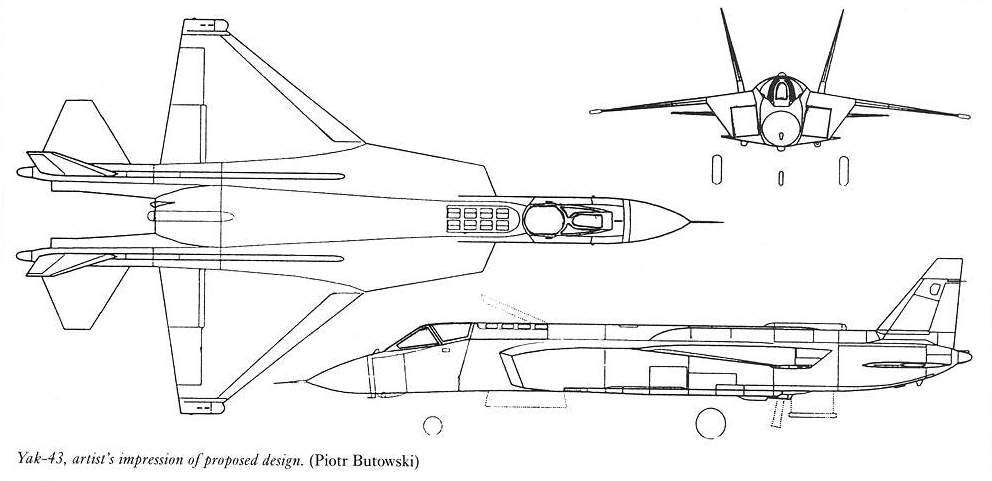Yak-141 Freestyle SpecificationsPrimary Function:Carrier Based InterceptorContractor:YakovlevCrew:OneUnit Cost:N/APowerplant One Kobchenko/Soyuz R-79-300 turbofan engine rated at 34,170lb for takeoff, two Rybinsk RD- 41 turbofan engines rated at 9,039lb for liftDimensionsLength:60 ft 2 inWingspan:33 ft 1.5 in (spread)
19 ft 4 in (folded)Height:16 ft 4 inWeightsEmpty:25,684 lbMaximum Takeoff:34,833 lb vertical, 42,990 lb shortPerformanceSpeed:1148.4 mph (Mach 1.8)Ceiling:49,000 ftRange:1306.8 miArmament One 30mm cannon, Alamo and Archer AAMs, bombs, and rockets
The YAK-141 is a STOVL.
F-35 Joint Strike Fighter SpecificationsPrimary Function:Strike fighter [Conventional Takeoff and Landing]Contractor:Lockheed-MartinCrew:OneUnit Cost (FY94$)$28MPowerplant One Pratt & Whitney F119-PW-100 derivative from F-22 RaptorDimensionsLength:45 feetWingspan:36 feetHeight:N/AWeightsEmpty:22,500 lbsMaximum Takeoff:50,000 lbsPerformanceSpeed:1,018 mph 1800 kphCeiling:N/ACombat Radius:over 600 nautical milesArmament N/A
F-35 is a STOVL.
-Yak-141 has a similar radar to the Mig-31, with a similar look down shoot down capability.
-F-35 has the advantage of stealth, but not much overall
-YAK-141 has higher speed advantage
-F-35 is most likely more expensive
- I need people to contribute information on the weapons systems.
-Agility is unknown.
19 ft 4 in (folded)Height:16 ft 4 inWeightsEmpty:25,684 lbMaximum Takeoff:34,833 lb vertical, 42,990 lb shortPerformanceSpeed:1148.4 mph (Mach 1.8)Ceiling:49,000 ftRange:1306.8 miArmament One 30mm cannon, Alamo and Archer AAMs, bombs, and rockets
The YAK-141 is a STOVL.
F-35 Joint Strike Fighter SpecificationsPrimary Function:Strike fighter [Conventional Takeoff and Landing]Contractor:Lockheed-MartinCrew:OneUnit Cost (FY94$)$28MPowerplant One Pratt & Whitney F119-PW-100 derivative from F-22 RaptorDimensionsLength:45 feetWingspan:36 feetHeight:N/AWeightsEmpty:22,500 lbsMaximum Takeoff:50,000 lbsPerformanceSpeed:1,018 mph 1800 kphCeiling:N/ACombat Radius:over 600 nautical milesArmament N/A
F-35 is a STOVL.
-Yak-141 has a similar radar to the Mig-31, with a similar look down shoot down capability.
-F-35 has the advantage of stealth, but not much overall
-YAK-141 has higher speed advantage
-F-35 is most likely more expensive
- I need people to contribute information on the weapons systems.
-Agility is unknown.

